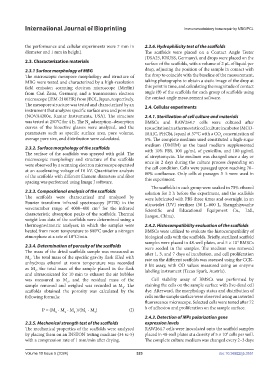Page 331 - IJB-10-5
P. 331
International Journal of Bioprinting Immunomodulatory bone repair by MBG/PCL
the performance and cellular experiments were 7 mm in 2.3.6. Hydrophilicity test of the scaffolds
diameter and 1 mm in height). The scaffolds were placed on a Contact Angle Tester
(DSA25, KRUSS, Germany), and drops were placed on the
2.3. Characterization materials surface of the scaffolds, with a volume of 2 μL of liquid per
2.3.1 Surface morphology of MBG drop, adjusting the position of the sample in contact with
The microscopic mesopore morphology and structure of the drop to coincide with the baseline of the measurement,
MBG were tested and characterized by a high-resolution taking photographs to obtain a static image of the drop at
field emission scanning electron microscope (Merlin) this point in time, and calculating the magnitude of contact
from Carl Zeiss, Germany, and a transmission electron angle (θ) of the scaffolds for each group of scaffolds using
microscope (JEM-2100HR) from JEOL, Japan, respectively. the contact angle measurement software.
The mesopore structure was tested and characterized by an 2.4. Cellular experiments
instrument that analyzes specific surface area and pore size
(NOVA4200e, Kantar Instruments, USA). The structure 2.4.1. Sterilization of cell culture and materials
was tested at 250°C for 4 h. The N adsorption–desorption BMSCs and RAW264.7 cells were cultured after
2
curves of the bioactive glasses were analyzed, and the resuscitation in a thermostatic cell culture incubator (MCO-
parameters such as specific surface area, pore volume, 18AIC, PHCbi, Japan) at 37°C with a CO concentration of
2
average pore size, and distribution were calculated. 5%. The complete medium used constituted a high-sugar
medium (DMEM) as the basal medium supplemented
2.3.2. Surface morphology of the scaffolds with 10% FBS, 100 μg/mL of penicillin, and 100 μg/mL
The surface of the scaffolds was sprayed with gold. The of streptomycin. The medium was changed once a day or
microscopic morphology and structure of the scaffolds once in 2 days during the culture process depending on
were observed by a scanning electron microscope operated the cell condition. Cells were passaged upon reaching 70–
at an accelerating voltage of 10 kV. Quantitative analysis 80% confluence. Only cells at passages 3–5 were used in
of the scaffolds with different filament diameters and fiber this experiment.
spacing was performed using Image J software.
The scaffolds in each group were soaked in 75% ethanol
2.3.3. Compositional analysis of the scaffolds solution for 2 h before the experiment, and the scaffolds
The scaffolds were characterized and analyzed by were lubricated with PBS three times and overnight in an
Fourier transform infrared spectroscopy (FTIR) in the ultraviolet (UV) sterilizer (30 L–800 L, Shengzhiyuanhe
wavenumber range of 4000–400 cm for the infrared Scientific and Educational Equipment Co., Ltd.,
-1
characteristic absorption peaks of the scaffolds. Thermal Jiangsu, China).
weight loss data of the scaffolds were determined using a
thermogravimetric analyzer, in which the samples were 2.4.2. Histocompatibility evaluation of the scaffolds
heated from room temperature to 800°C under a nitrogen BMSCs were utilized to evaluate the histocompatibility of
atmosphere at a rate of 10°C/min. biological cells with the scaffolds. Briefly, sterilized scaffold
samples were placed in 48-well plates, and 5 × 10 BMSCs
4
2.3.4. Determination of porosity of the scaffolds were seeded in the samples. The medium was removed
The mass of the dried scaffolds sample was measured as after 1, 3, and 7 days of incubation, and cell proliferation
M . The total mass of the specific gravity flask filled with rate on the different scaffolds was assessed using the CCK-
0
anhydrous ethanol at room temperature was recorded 8 kit assay, with OD values measured using an enzyme
as M , the total mass of the sample placed in the flask labeling instrument (Tecan Spark, Austria).
1
and ultrasonicated for 10 min to exhaust the air bubbles
was measured as M , and the residual mass of the Cell viability assay of BMSCs was performed by
2
sample removed and weighed was recorded as M . The staining the cells on the sample surface with live-dead cell
3
scaffolds obtained the porosity was calculated by the dye. Afterward, the morphology status and distribution of
following formula: cells on the sample surface were observed using an inverted
fluorescence microscope. Selected cells were tested after 72
P = (M - M - M )/(M - M ) (I) h of adhesion and proliferation on the sample surface.
2 3 0 1 3
2.4.3. Detection of MPs polarization gene
2.3.5. Mechanical strength test of the scaffolds expression levels
The mechanical properties of the scaffolds were analyzed RAW264.7 cells were inoculated onto the scaffold samples
by placing them on an INSTON testing machine (34 sc-5) placed in 48-well plates at a density of 5 × 10 cells per well.
4
with a compression rate of 1 mm/min after drying. The complete culture medium was changed every 2–3 days
Volume 10 Issue 5 (2024) 323 doi: 10.36922/ijb.3551

